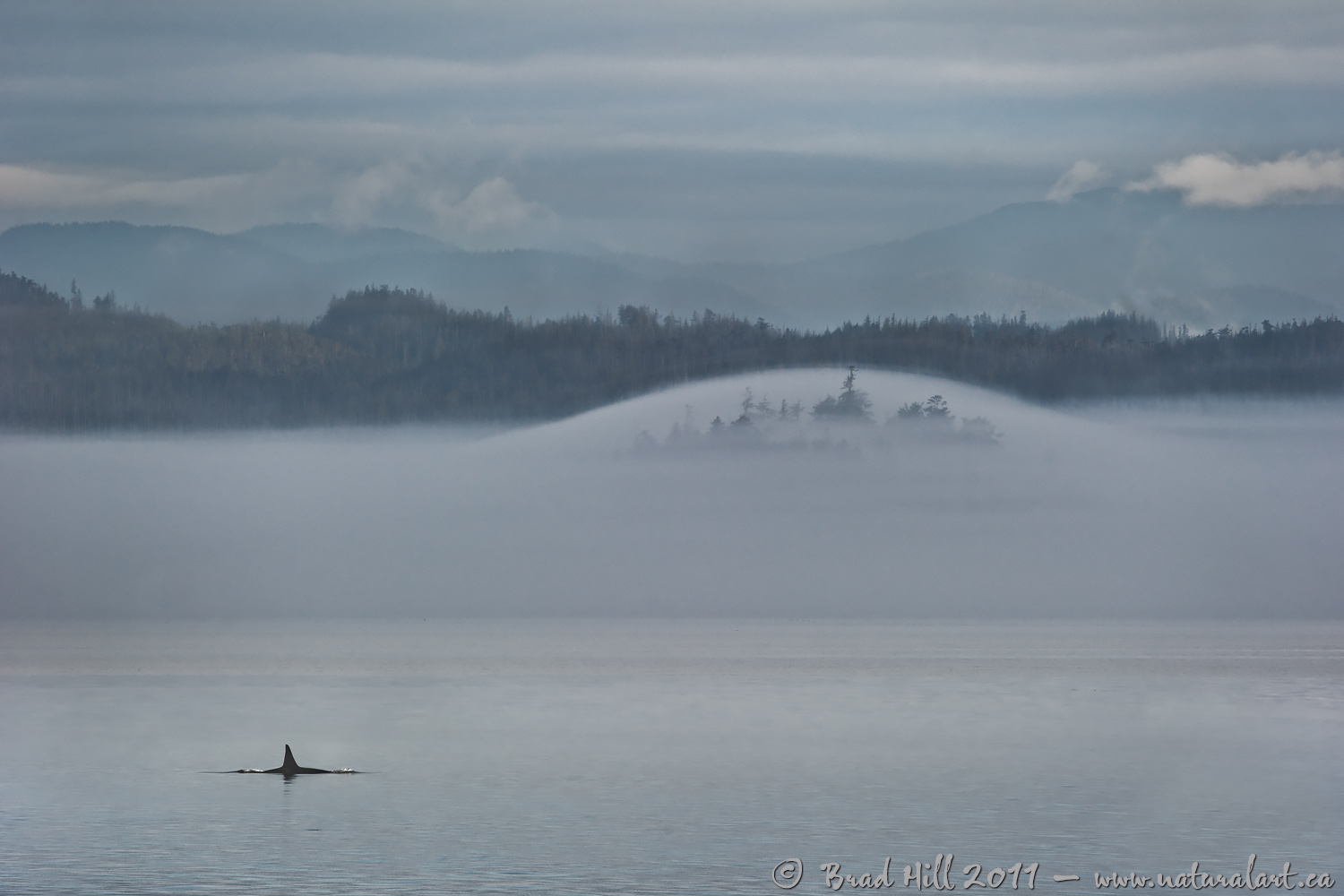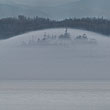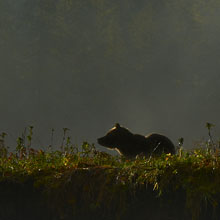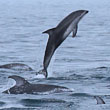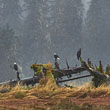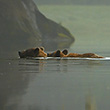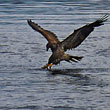Availability: Limited Edition Print - info coming soon!
In the Field
Solitude. Blackfish Sound (northern Vancouver Island), BC, Canada. August 25, 2010.
And now...something just a little different! In this animalscape* shot the subject takes up only about two tenths of a single percent (0.2%!) of the frame...
This image took a lot of patience to capture. When first I saw this fantastic fog "bubble" over a small island in Blackfish Sound I knew I had to find a way to work with it. We had a number of Orcas around our boat and I hoped that in time one or more of them would swim into position to give me the shot I wanted. So, for about an hour or so I kept my eye on the "bubble" while shooting images of the Orcas in various other places and scenes. Eventually I saw an Orca swimming toward the bubble - but by this time we were a long ways off. Fortunately I had a 600mm lens mounted on a tripod ready to go, so I quickly composed the scene I wanted to capture (dividing the frame into 3 nearly equal portions of water, land, and sky) and waited. Fortunately for me the whale continued on its path and swam into the exact position I wanted it to. So then it was simply "snap" (or more accurately, "click, click, click, click").
When I later looked at the raw files I saw that the 600mm lens had done it's job and compressed the distances between the whale, island, and background the way I hoped. But I also saw an image which had only pastel colours in it and which was almost impossibly flat (i.e., completely monotone with almost no depth or tonal range to it). To come up with this final image took a lot of "pixel-pushing", primarily with the contrast of the image (and primarily with the mid-tones). It took awhile, but eventually I returned the image to resemble (accurately, I think) to what I saw in the field. And this is it...
Here's a higher resolution (2400 pixel) version of this serene and surreal scene:
• Solitude: Download 2400 pixel image (JPEG: 0.85 MB)
ADDITIONAL NOTES:
1. This image - in all resolutions - is protected by copyright. I'm fine with personal uses of it (including use as desktop backgrounds or screensavers on your own computer), but unauthorized commercial use of the image is prohibited by law. Thanks in advance for respecting my copyright!
2. Like all wildlife photographs on this website, this image was captured following the strict ethical guidelines described in The Wildlife FIRST! Principles of Photographer Conduct. I encourage all wildlife photographers to always put the welfare of their subjects above the value of their photographs.
3. This image was captured during my "Humpback, Orcas, Sea Lions & More" photo tour in August of 2010. Each year I offer trips into two different parts of the Great Bear Rainforest as well as one to photograph aquatic mammals and oceanscapes near the northern tip of Vancouver Island. And, in selected years, I also offer photo tours to locations to capture other highly sought-after subjects, such as various owl species of the boreal forest and wildlife of Canada's Arctic. Details about these trips can be found on the Photo Tours page of this website.
*4. For a more detailed discussion of the image types I call animalscapes and enviroscapes (and the subtle distinctions between them), just go here...
Behind the Camera
Solitude. Blackfish Sound (northern Vancouver Island), BC, Canada. August 25, 2010.
Digital Capture; RAW 14-bit format; ISO 720.
Nikon D3s with Nikkor 600mm f4 VR lens supported on Gitzo 1348 tripod with Wimberley head. VR on and set to "Normal" mode.
1/1250s @ f5.6; no compensation from matrix-metered exposure setting of camera.
At the Computer
Solitude. Blackfish Sound (northern Vancouver Island), BC, Canada. August 25, 2010.
RAW Conversion to 16-bit TIFF, including first-pass/capture sharpening using Phase One's Capture One Pro 5.
Further digital corrections on 16-bit TIFF file using Adobe's Photoshop CS5 and Light Craft's LightZone. Photoshop adjustments included selective curves adjustment and selective exposure adjustments. Lightzone used for final "tone-tweaking", especially to midtone contrast.
Conservation
Solitude. Blackfish Sound (northern Vancouver Island), BC, Canada. August 25, 2010.
Ten percent of the revenue generated by this image will be donated to Raincoast.
Species Status in Canada*: Endangered - Northeast Pacific southern resident population; Threatened - Northeast Pacific transient population and the Northeast Pacific northern resident population; Special Concern - Northeast Pacific offshore population.
Killer Whales (Orcinus orca) have an extremely high profile in modern pop culture and have become the "poster child" of a number of conservation groups. In most areas where Killer Whales are found they show a remarkable ability to adapt to a variety of habitats - they are found in all oceans, in water ranging in temperature from below 0 Celsius to almost hot tropical waters, and will occasionally even spend significant amounts of time in brackish water or even rivers.
Because the population sizes of Killer Whales are very low and because they have a very low reproductive rate, they face immediate risk from human-related environmental disturbances, including the immunotoxic effects of toxic chemicals we pour into the oceans and to reduction in prey availability (such as salmon).
These two Killer Whales were photographed along the coast in British Columbia's Great Bear Rainforest. The Raincoast Conservation Society is fighting to protect the Great Bear Rainforest along the central and northern coast of British Columbia. This unique ecosystem harbours a strong population of many high-profile species such as Brown Bears and Gray wolves, plus many species that serve as prey for the Killer Whale. If you are looking for a meaningful way to contribute to the conservation of the Great Bear Rainforest and all its associated species, Raincoast will provide maximal "bang" for your conservation dollars.
For more information on the status of Killer Whales in Canada, go to: http://www.speciesatrisk.gc.ca and search under "Killer Whale".
*as determined by COSEWIC: The Committee on the Status of Endangered Wildlife in Canada













